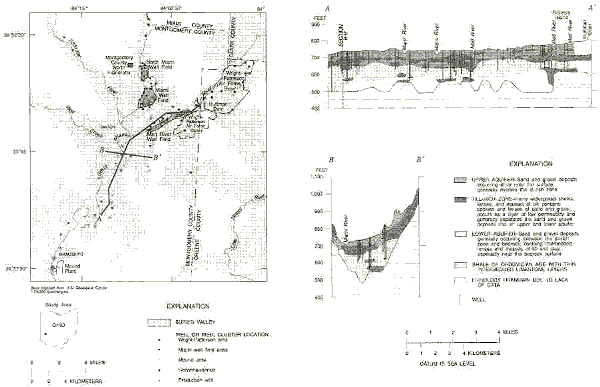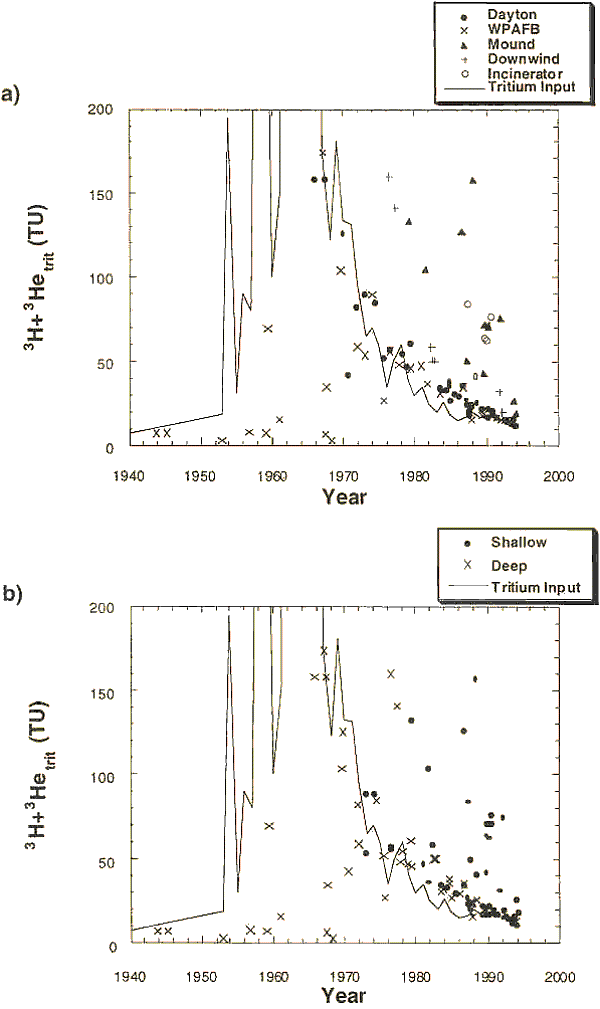Ohio Research
In This Document:
Summary
The 3H-3He dating method is applied in a buried-valley aquifer near Dayton, Ohio. The study area is large, sampling locations do not all lie along well-defined flowpaths, and existing wells with variable screen lengths and diameters are used. Reliable use of the method at this site requires addressing several complications: (1) the flow system is disturbed due to high pumping rates and induced infiltration; (2) tritium contamination is present in several areas of the aquifer; and (3) radiogenic helium concentrations are elevated in a significant number of the wells. The 3H-3He ages are examined for self-consistency by comparing the reconstructed tritium evolution to the annual weighted tritium measured in precipitation; deviations result from dispersion, tritium contamination, and mixing. The 3H-3He ages are next examined for consistency with chlorofluorocarbon ages; the agreement is poor because of degradation of CFCs. Finally, the 3H-3He ages are examined for consistency with the current understanding of local hydrologic processes; the ages are generally supported by hydrogeologic data and the results of ground-water flow modeling coupled with particle tracking analyses.
Investigators:
Stephanie Dunkle Shapiro (Lamont-Doherty Earth Observatory of Columbia University, Palisades, New York, Department of Earth and Environmental Sciences, Columbia University, New York,U.S. Geological Survey, Reston, Virginia), Gary Rowe(U.S. Geological Survey, Columbus, Ohio), Peter Schlosser(Lamont-Doherty Earth Observatory of Columbia University, Palisades, New York, Department of Earth and Environmental Sciences, Columbia University, New York), Andrea Ludin(Lamont-Doherty Earth Observatory of Columbia University, Palisades, New York, Department of Earth and Environmental Sciences, Columbia University, New York), and Martin Stute (Lamont-Doherty Earth Observatory of Columbia University, Palisades, New York, Department of Environmental Science, Barnard College, New York)
Publications:
Rowe, G.L. Jr., S.D. Shapiro, and P. Schlosser, 1999, Use of Environmental Tracers to Evaluate Ground-Water Age and Water-Quality Trends in a Buried-Valley Aquifer, Dayton Area, Southwestern, Ohio: U.S. Geological Survey Water-Resources Investigations Report 99-4113, 81p.
Shapiro, S.D., 1998, Evaluation of the 3H-3He Dating Technique in Complex Hydrologic Environments: Ph.D. Dissertation, 254 p., Department of Earth and Environmental Science, Columbia University in the City of New York.
Shapiro, S.D., G. Rowe, P. Schlosser, A. Ludin, and M. Stute, 1998, Tritium-helium 3 Dating Under Complex Conditions in Hydraulically Stressed Areas of a Buried-Valley Aquifer: Water Resources Research, v.34, no.5, pp.1165-1180.
Sheets, R.A., E.S. Bair, and G.L. Rowe, Flow Model Evaluation by Use of Tritium-Helium-3 Isotopes in a Complex Buried-Valley Aquifer, Water Resources Research, v.34, no.5, 1998.
Sheets, R., G. Rowe, S. Bair, S.D. Shapiro, P. Schlosser, and R. McCready, in press, Use of Environmental Tracers to Evaluate Two Ground-Water-Flow Models, near Dayton, Ohio: Abstract, ModelCARE 96, Golden, Colorado, September 1996.
Illustrations:

(a) Map of study area showing sampling locations and cross-sections A-A' and B-B'. (b) Geologic cross-sections A-A' and B-B'

[3H]+[3Hetrit] versus 3H-3He recharge year by subgroup locations (a) and by depth (b). Tritium input for central Ohio included for comparison (see text for discussion).